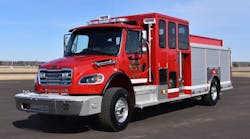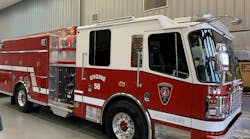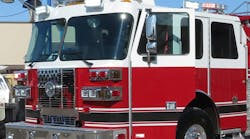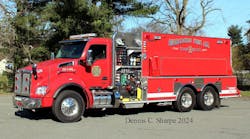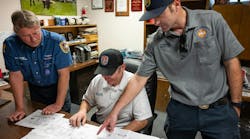At this point, it would be helpful to seek out the expertise of an apparatus architect. If your department is a first-time aerial apparatus purchaser, spending a few dollars up front to retain the services of someone who knows what he or she is doing (an apparatus architect) is a must. The apparatus architect could save you hundreds of thousands of dollars and you could end up with a far better apparatus with greater longevity.
Aerial apparatus purchased in the 1950s and 1960s were predominantly built with midship-mounted turntables installed directly behind the cab of the unit. With the exception of articulating booms such as Snorkels, the fire service had pretty much employed these midship aerial ladders as the standard aerial device. A few big-city fire departments such as Chicago and FDNY used Magirus rear-mounted aerial devices that were imported from Germany and installed on Mack chassis in order to gain some additional vertical reach above the traditional four-section 100-foot aerial ladders.
In 1967, Seagrave introduced the Rear Admiral series of ladders that featured rear-mounted turntables built on wheelbases as short as 210 inches. This not only eliminated the rear ladder overhang, but reduced the overall length of the apparatus as well. Not to be outdone, American LaFrance produced its first Ladder Chief rear-mount unit the following year and since that time virtually every manufacturer has offered both midship- and rear-mounted aerial ladders.
Let’s look at some of the advantages of midship-mounted turntable aerial devices. First, when positioning a ladder truck with a midship-mounted turntable, you can position the truck more readily as the driver can easily judge the position of the centerline of the turntable with the building. This enables the driver to place the apparatus to achieve the maximum use of the aerial device for horizontal or vertical position. The old adage “You can stretch a hoseline, but you cannot stretch a ladder” is certainly appropriate. Second, with the midship device you increase the scrub area that you can reach on a building as compared to a rear-mounted device. This is due to gaining the effective length of the ladder by placing the turntable closer to the building, particularly when operating off the front of the apparatus as well as the sides between 9 and 3 o’clock with respect to the centerline of the chassis. Depending upon the streets and building setbacks in your first-due area, this feature alone could “make or break” some of your fireground operations.
Midship aerial devices generally provide for shorter overall travel height where station door clearance or other overhead obstructions are a concern. However, you must be careful to specify the appropriate overall vehicle height that meets your needs, without accepting a special low-profile model that may not provide for adequate compartmentation and ground ladder storage to meet your needs. Many departments, particularly those in the East, must operate from older fire stations that have a fixed door or beam clearance that would preclude them from specifying an aerial truck with a travel height over 11 feet.
It is poor policy to design fire apparatus to fit fire stations. Considering that the next aerial apparatus your department purchases will have to be in service for 25 to 30 years or more, it may be wise to hold off making that purchase if there is a chance to renovate your existing station or to build a new station to fit a modern-day aerial device. Your apparatus committee needs to make sure that whatever the maximum allowable travel height can be for your jurisdiction, that this number be clearly communicated in your specifications and that you fully understand what impact this has on the design and storage space within the body compartments.
We have probably all heard about some fire department that went to accept its new ladder truck from the manufacturer, only to find out that it did not fit the station or through some critical overpass in the community. Even more embarrassing is when you go to place all of your truck company hands tools and equipment on the new rig, only to find out that the compartments are filled up before you have found a home for everything that you want to carry.
Another consideration with midship-mounted aerial devices is that in most instances they are designed to reduce the overall travel height of the apparatus and this may limit the number of ground ladders that the vehicle can accommodate and how they are carried inside the apparatus body. Every manufacturer must provide the National Fire Protection Association (NFPA) required minimum ground ladders of 85 feet on a quint and 115 feet on a non-quint aerial apparatus. While this may meet the standard, this ground ladder complement may be inadequate to cover the buildings in your first-due area and significantly less than what your present ladder company apparatus carries. Make sure that the apparatus committee carefully reviews and considers what your requirements for ground ladders are when designing the new apparatus.
The banking height for ground ladders is different for solid-beam vs. truss-style ladders and this must be considered as well when determining the appropriate ground ladder complement for your new apparatus. Do not let the manufacturer’s representative sell you on “the truck is fully NFPA compliant” as being the seal of approval for anything. NFPA 1901 is only a minimum standard. If the new truck does not meet the needs of your fire department, then change, adapt or modify the design to make sure that it does. Manufacturers that are truly interested in your business will be more than happy to figure out, with the assistance of their engineering departments, how to configure the ground ladder arrangement and banking to meet your needs or to develop alternative solutions for problems that you may encounter.
Where fire station bay length and maneuverability is a concern, the rear-mounted turntable unit may be preferred for a number of reasons. The rear-mount aerial ladder offers a significantly shorter overall length when compared to a midship unit. In addition, the ladder overhang over the cab generally allows for a shorter turning radius when combined with improved steering geometry, which can be important when operating on narrow streets or in apartment complexes. Since rear-mount ladders generally have higher overall travel heights, there are fewer restrictions on compartment and ground ladder options.
One of the perceived drawbacks of rear-mount aerial devices is that when positioning the rig, you can lose the length of the vehicle when placing the truck in the front of the fire building due to the turntable being at the rear of the truck. This can be overcome by positioning the center of the turntable with the middle of the objective that you are trying to reach. This will allow for the maximum scrub area on the front of the building, without having the truck block critical access for other incoming units. There are significant operational and placement considerations between the midship- and rear-mounted aerial devices and the truck committee should carefully review these before setting out to develop the specifications for your new truck. If the operational considerations between midship and rear-mounted aerial devices are not fully understood, there are training classes available that can help educate your truck committee on the significant differences that exist.
In the next installment of The Apparatus Architect we will discuss aerial ladder truck design considerations that you may wish to include in your specifications. Knowledge of the components and how they relate to the overall design will help you in developing a comprehensive set of specifications for your next ladder company apparatus.
Tom Shand is a firefighter with the Newton-Abbott Volunteer Fire Department in the Town of Hamburg, NY, and a senior instructor at the Onondaga County Community College Public Safety Training Center. He is employed by American LaFrance and is assigned to the Hamburg Facility in the apparatus sales department. Michael Wilbur, a Firehouse® contributing editor, is a lieutenant in the New York City Fire Department, assigned to Ladder Company 27 in the Bronx, and has served for the past five years on the FDNY Apparatus Purchasing Committee. He has consulted on a variety of apparatus related issues throughout the country. For further information access his website at www.emergencyvehicleresponse.com.



